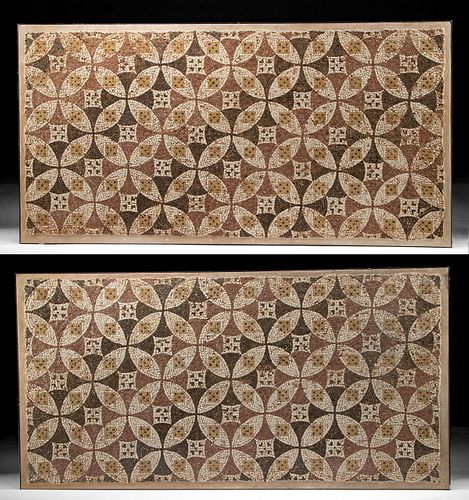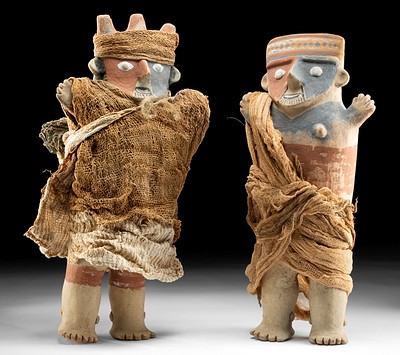Pair of Huge Byzantine Stone Mosaics w/ Geometric Motif
Lot 48
About Seller
Artemis Fine Arts
686 S Taylor Ave, Ste 106
Louisville, CO 80027
United States
Selling antiquities, ancient and ethnographic art online since 1993, Artemis Gallery specializes in Classical Antiquities (Egyptian, Greek, Roman, Near Eastern), Asian, Pre-Columbian, African / Tribal / Oceanographic art. Our extensive inventory includes pottery, stone, metal, wood, glass and textil...Read more
Estimate:
$24,000 - $36,000
Absentee vs Live bid
Two ways to bid:
- Leave a max absentee bid and the platform will bid on your behalf up to your maximum bid during the live auction.
- Bid live during the auction and your bids will be submitted real-time to the auctioneer.
Bid Increments
| Price | Bid Increment |
|---|---|
| $0 | $25 |
| $300 | $50 |
| $1,000 | $100 |
| $2,000 | $250 |
| $5,000 | $500 |
| $10,000 | $1,000 |
| $20,000 | $2,500 |
| $50,000 | $5,000 |
| $100,000 | $10,000 |
| $200,000 | $20,000 |
About Auction
By Artemis Fine Arts
May 19, 2022
Set Reminder
2022-05-19 10:00:00
2022-05-19 10:00:00
America/New_York
Bidsquare
Bidsquare : Fine Antiquities | Ethnographica | Fine Art
https://www.bidsquare.com/auctions/artemis-gallery/fine-antiquities-ethnographica-fine-art-9350
Featuring a very special collection of Fine Art from the Hollywood Hills, including Picasso & Rookwood ceramics! Also included are many fine examples of classical antiquities, ancient, and ethnographic art from cultures encompassing the globe. Artemis Fine Arts info@artemisfinearts.com
Featuring a very special collection of Fine Art from the Hollywood Hills, including Picasso & Rookwood ceramics! Also included are many fine examples of classical antiquities, ancient, and ethnographic art from cultures encompassing the globe. Artemis Fine Arts info@artemisfinearts.com
- Lot Description
Near Eastern, Eastern Empire, Early Byzantine Period, ca. 7th century CE. An opulent pair of ornamental floor or wall mosaics, each of a massive, rectangular form and featuring an ornate design delineated in thousands of square, rectangular, and triangular stone tesserae of mauve, citron, white, and black hues. Both panels boast identical, intricate motifs comprised of intersecting circles forming quatrefoils and stylized crosslets. The petal of each flower is adorned by a yellow square containing 5 black tesserae, while the field between each flower displays a white square with concave peripheries and a black quatrefoil inside. Size of largest mosaic (both about the same): 35.3" W x 70.7" H (89.7 cm x 179.6 cm); Size of largest frame (both about the same): 37.6" W x 73.8" H (95.5 cm x 187.5 cm)
Mosaics (opus tesellatum) are some of our enduring images from the Roman world, not only for their aesthetic beauty, but also because they reveal what Romans chose to depict and see every day decorating their private and public spaces. This example is abstract in its intention and presents the ancients' keen eye for design and fascination with geometry. In the Roman province of Syria, which encompassed most of the ancient Near East/Levant, mosaics seem to have developed as a popular art form relatively late, with most finds coming from the 3rd century CE or later. Syria was one of Rome's wealthiest provinces, but it was also far removed from Rome itself and Roman culture was overlaid on enduring cultural traditions from Hellenistic Greece and the great civilizations that came before it. For example, Antioch-on-the-Orontes (modern day Antakya, Turkey), was the capital of northern Roman Syria, and its excavations in the 1930s revealed more than three hundred mosaic pavements. Popular mosaic themes from this region were often mythological or religious scenes, depicting gods and goddesses; however, sometimes mosaics were created to fit the theme of a building or room.
The geometric pattern of intersecting circles seen in these examples was tremendously popular throughout the Eastern Empire. According to archeologist Zeidoun Al-Muheisen and art historian Mohammad Nassar, "The intersecting circles motif became widespread in Jordan during the Byzantine period. One example is in the southern intercolumniation and the southern aisle of the nearby Khirbet al-Bediyeh church (640). A similar example is at Madaba, in the north intercolumnar panel of the church of the Apostles (578). Others are in the north aisle of the church of Bishop Leontios at Ya'amun at Rehab in the apse of the church of Saint Menas (635), and at Gerasa in the chancel of the Bishop Marianus chapel (570). This motif too is a good deal older, found in the Hellenistic period and common throughout the Roman period. One example is in the Hospitalia of Hadrian’s Villa at Tivoli (118). Others are in Turkey: one is in Terrace House 2 at Ephesus (late III/early IV). Three are at Aphrodisias: in the Basilica (365–380), where the intersecting circles are dark blue and the quatrefoils are white and yellow with white, while the crosslet on the central curvilinear is dark blue; in the North Room of the Temenos Complex (350–375), where again the central quatrefoils are decorated with crosslets similar to those at Ras ed-Deir; and in Room 5 of the Priest’s House (mid-V), where the centers of the quatrefoils have small crosslets." (Al-Muheisen, Zeidoun & Nassar, Mohammad. 2014. "Geometric Mosaic Pavements at Ras ed-Deir, Jordan." Greek, Roman and Byzantine Studies. 54. pgs. 98-99.)
Provenance: private Vero Beach, Florida, USA collection; ex-private European collection, acquired between 1970 to 1980; ex-private Lebanon collection, imported to US in 1988
All items legal to buy/sell under U.S. Statute covering cultural patrimony Code 2600, CHAPTER 14, and are guaranteed to be as described or your money back.
A Certificate of Authenticity will accompany all winning bids.
PLEASE NOTE: Due to recent increases of shipments being seized by Australian & German customs (even for items with pre-UNESCO provenance), we will no longer ship most antiquities and ancient Chinese art to Australia & Germany. For categories of items that are acceptable to ship to Australia or Germany, please contact us directly or work with your local customs brokerage firm.
Display stands not described as included/custom in the item description are for photography purposes only and will not be included with the item upon shipping.
#170084Expected surface wear, commensurate with age. A few small areas of missing tesserae. Otherwise, excellent and superbly preserved. The mosaic is mounted on honeycomb, an expensive but useful process that lightens the piece by two thirds for ease of handling and display.Condition
- Shipping Info
-
All shipping is handled in-house for your convenience. Your invoice from Artemis Gallery will include shipping calculation instructions. If in doubt, please inquire BEFORE bidding for estimated shipping costs for individual items.
-
- Buyer's Premium



 EUR
EUR CAD
CAD AUD
AUD GBP
GBP MXN
MXN HKD
HKD CNY
CNY MYR
MYR SEK
SEK SGD
SGD CHF
CHF THB
THB

















